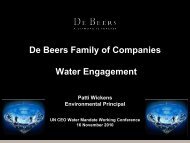Robert Greenwood (Principal, Ross Strategic) - UN CEO Water ...
Robert Greenwood (Principal, Ross Strategic) - UN CEO Water ...
Robert Greenwood (Principal, Ross Strategic) - UN CEO Water ...
- No tags were found...
You also want an ePaper? Increase the reach of your titles
YUMPU automatically turns print PDFs into web optimized ePapers that Google loves.
Guide to <strong>Water</strong>-RelatedCollective Action<strong>CEO</strong> <strong>Water</strong> Mandate MumbaiWorking SessionMarch 7, 2012
Guide to <strong>Water</strong>-Related Collective Action | 2Societal Risks by Severity and LikelihoodSource: World Economic Forum 2012
Guide to <strong>Water</strong>-Related Collective Action | 3Risk and ControlImpact on CompanyDirectoperationsSupplieroperations<strong>Water</strong>shedconditionsCompany InfluenceDirectoperationsSupplieroperations<strong>Water</strong>shedconditions
SuccessGuide to <strong>Water</strong>-Related Collective Action | 4From Challenge to Systematic, Sustainable OutcomeExit collectiveaction as riskreduces throughachievingcollective actionobjectives and/orinstitutionalizationof externalcapacity & interestEvaluate CA need and Determineappropriate CA processInitiate CollectiveActionBuild Capacity & InterestTime
Guide to <strong>Water</strong>-Related Collective Action | 5Background• Collective Action Guide Initiated March 2012• Collaboration Among• <strong>CEO</strong> <strong>Water</strong> Mandate• <strong>Water</strong> Futures Partnership• Pacific Institute (rep. Mandate Secretariat)• Pegasys Strategy and Development• <strong>Ross</strong> <strong>Strategic</strong>• Official Release at Stockholm WWW 2012• Beta Version 1.0
Guide to <strong>Water</strong>-Related Collective Action | 6
Guide to <strong>Water</strong>-Related Collective Action | 7Case Example Contributors• AB-InBev• Finlays Horticulture• Molson Coors BrewingCompany• Sasol New Energy• Anglo American• SABMiller• SEAAWA• Nike, Levi, H&M, Nautica• Suez Environment• The Coca-Cola Company
Guide to <strong>Water</strong>-Related Collective Action | 8Why a Collective Action Guide?• Collective action when effective:• Fresh ideas and perspectives• Credibility and legitimacy• Momentum for change• Resources to address common objectives• Resilient solutions• Collective action challenges:• Non-conventional relationships, non-traditional partners• Complex needs, interests, personalities, organizational structures• Public scrutiny, unrealistic expectations, skepticism about motives• <strong>CEO</strong> <strong>Water</strong> Mandate Guide to <strong>Water</strong>-Related Collective Action• Optimize collective effort, common objectives, shared outcomes• Minimize risk of inefficient process, miscommunication, poor outcomes
Guide to <strong>Water</strong>-Related Collective Action | 9Positioning Collective Action• Coordinated engagement among interested parties insupport of common objectives• Emphasis on joint, two-way dialog• produces stronger outcomes than unilateral action• Range of forms• Informal information exchange and consultation to• Structured joint decision making, implementation,and accountability• Effective collective action tailored• needs, objectives, conditions, and capabilities
Guide to <strong>Water</strong>-Related Collective Action | 10Scope and Purpose• Companies new to external engagement• Internal scoping of collective action needs/options• Prepare company to initiate external party discussions• Assist in unpacking the balance between:• Motivation for engagement in multi-party collaborativeefforts as the backbone of SWM progress• Requirements for effective collective action = ability andwillingness to embrace joint interests, shared goals, andcommon objectives• Two companion efforts:• <strong>Water</strong> Action Hub• <strong>Water</strong> Futures Partnership Compendium of LessonsLearned
Guide to <strong>Water</strong>-Related Collective Action | 11Collective Action Guide: Overview• Section 1: Introduction• Section 2: Scope and Purpose of the Collective Action Guide• Section 3: Understanding <strong>Water</strong>-Related Collective Action• Section 4: Preparing for Collective Action• Section 5: Structuring and Managing Collective Action• Appendices:• Resources• Structured Analysis Frameworks
Guide to <strong>Water</strong>-Related Collective Action | 12Understanding <strong>Water</strong>-Related CollectiveAction: Driver and Motivations• Risk & Stewardship• Managing operational pressures resulting frominadequate availability, supply, or quality• Maintaining/enhancing legal/social license to operateby demonstrating responsible resource management• Assuring investors and other stakeholders water risksadequately addressed• Uphold corporate values and commitments related tosustainable development• Collective action desirable/necessary whenunilateral action will not produce these outcomes
Guide to <strong>Water</strong>-Related Collective Action | 13<strong>Water</strong> Management Domains and Degreeof ControlCatchments withSupplier OperationsCatchments withCompany OperationsSupplier Operations• Optimize <strong>Water</strong> Use• Minimize <strong>Water</strong>Resource ImpactsCompany Operations• Optimize <strong>Water</strong> Use• Minimize <strong>Water</strong>Resource ImpactsWATER MANAGEMENT INTERDEPENDENCEHigh Direct Control Medium to Low Direct Control Indirect Control
Guide to <strong>Water</strong>-Related Collective Action | 14Understanding <strong>Water</strong>-Related CollectiveAction• Public sector primary responsibility for sustainablewater management• Public sector may suffer from:• Inadequate financial resources• Insufficient institutional capacity• Inappropriate governance mechanisms• <strong>Water</strong>-related challenges can arise and escalate• Collective action responds to these deficiencies• Engagement tied to local/catchment-level outcomes
Guide to <strong>Water</strong>-Related Collective Action | 15Benefits of Collective Action• Clear articulation of problems, shared ownership of solutions,clarity of joint purpose• More informed decision making by the business initiator andother parties to the engagement• Broader scope and depth of motivation and momentum insupport of water-related improvements• An expanded pool of expertise, capacity, or financial resourcesfocused on fostering change• More durable outcomes that are supported by the engagedparties• Establishment and maintenance of credibility and legitimacywith critical interested parties• Stronger water governance by engaging multiple stakeholders,including all water users
Guide to <strong>Water</strong>-Related Collective Action | 16Collective Action Preparation• Internal analysis and dialog to understand:• water challenges action areas,• interested parties, and• engagement options.• Create solid footing for initiating externaldiscussions and collective action implementation• Possibility of partner as “guide” to approachingcollective action considering• capacity, networks, reputation, and mandate
Guide to <strong>Water</strong>-Related Collective Action | 17Collective Action Preparation and ImplementationELEMENT 1:Articulating <strong>Water</strong>-RelatedChallenges and Action Areas(Section 4.1)ELEMENT 2:Characterizing the InterestedParty Landscape(Section 4.2)ELEMENT 3:Selecting a Collective Action Level of Engagement(Section 4.3)ELEMENT 4:Preparing for Collective Action(Section 4.4)ELEMENT 5:Implementation, Refinement and Evolution(Section 5)
Guide to <strong>Water</strong>-Related Collective Action | 18Discussion Segment OneLinking <strong>Water</strong> Resources ManagementChallenges and Collective Action
Guide to <strong>Water</strong>-Related Collective Action | 19<strong>Water</strong> Resource Management CycleCatchment <strong>Water</strong> Resource<strong>Water</strong> Infrastructure SystemUpstream <strong>Water</strong>Resources<strong>Water</strong> Supply andTreatmentCatchmentEcosystems<strong>Water</strong>Governance &ManagementCompany, Supplier,and Community<strong>Water</strong> UsesReceiving <strong>Water</strong>ResourcesWaste <strong>Water</strong> andStormwater Treatmentand Discharge
Guide to <strong>Water</strong>-Related Collective Action | 20Characterizing <strong>Water</strong>-Related Challenges, Causes, and RisksDrivers of<strong>Water</strong> ResourceState<strong>Water</strong>ManagementSystem<strong>Water</strong>-RelatedChallengesCompanyInterestsEconomicDevelopmentDemographicShiftsChanges toquality,quantity, oravailability;alterations togoals orobjectivesInfrastructureManagementand Funding<strong>Water</strong>Governance andRegulationInsufficientresponse towatermanagementpressuresandrequirements<strong>Water</strong> Over-Allocation<strong>Water</strong>Supply/SanitationUnreliable/Unavailable<strong>Water</strong> QualityDeteriorationDirectoperationalimpacts orconcernedcommunityactors orcustomersPhysical RiskRegulatory RiskClimateVariability<strong>Water</strong> Planning,Management,and PricingFlood DamageReputationalRiskSocial NormsandExpectationsEcosystemDegradationStewardshipOpportunity
Guide to <strong>Water</strong>-Related Collective Action | 21Potential Collective Action Areasfrom the <strong>Water</strong> Action HubnEfficient <strong>Water</strong> UseEffluent Management,Wastewater Reclamation, ReuseCommunity-Level Access to Safe<strong>Water</strong>, Sanitation, and HygieneStorm <strong>Water</strong> Management andFlood ControlInfrastructure Finance,Development, Operation, orMaintenanceSustainable AgricultureClimate Change Adaptation andResilienceEcosystem, Source <strong>Water</strong>Protection, RestorationMonitoring and KnowledgeSharingEngaging in ParticipatoryPlatformsPublic Awareness and EducationImproved <strong>Water</strong> Governance,Policy Development, andImplementation
Guide to <strong>Water</strong>-Related Collective Action | 22From Challenge to ActionIMMEDIATE WATER CHALLENGE<strong>Water</strong> Quality Deterioration:SedimentationWATER MANAGEMENT SYSTEM DEFICIENCY<strong>Water</strong> Governance and Regulation:Regulation of land management practicerequirements to prevent sedimentation lackingDRIVER OF WATER RESOURCE STATEEconomic Development:Expansion of basin agricultural activityACTION AREA A:SustainableAgricultureACTION AREA B:Improved <strong>Water</strong>Governance andPolicy DevelopmentACTION AREA C:Engaging inParticipatoryPlatformsACTION AREA D:PublicAwareness andEducation
Guide to <strong>Water</strong>-Related Collective Action | 23Scoping <strong>Water</strong>-Related Challenges andExplore three questions:Action Areas1. What are your priority water-related challengesin the catchment of concern?2. What socioeconomic drivers and underlyingdeficiencies in the water system lead to thechallenges?3. Which type of interventions (action areas) willbest address the problems you have identified?
Guide to <strong>Water</strong>-Related Collective Action | 24Discussion Segment TwoEngaging on <strong>Water</strong>: With Whom, onWhat Topic
Guide to <strong>Water</strong>-Related Collective Action | 25Understanding Prospective ExternalParty Participants• Many potential interests, organizations, individuals• Those sharing the water resource• Community-based organizations• Producer co-operatives• Governmental water managers• NGOs with water or community-related missions• Donors and aid agencies• Infrastructure managers• Research institutions• Analysis to identify critical, legitimate, and relevantinterested parties
Guide to <strong>Water</strong>-Related Collective Action | 26Identifying Critical Participants• Six Point Analysis• Decision Point• Opportunity• Expertise• Impacts• Expectations• Conflict
Guide to <strong>Water</strong>-Related Collective Action | 27Identifying & Characterizing ProspectiveParticipantsExplore three questions:1. Who has what type of interest in yourchallenges and planned action areas?2. Who can best help address your challenges?3. Who needs to be part of the solution(s) thatwill address your challenges?
Guide to <strong>Water</strong>-Related Collective Action | 28Discussion Segment ThreeScoping the Collective Action Level(s) ofEngagement
Guide to <strong>Water</strong>-Related Collective Action | 29Understanding Collective ActionLevels of Engagement• Four levels of engagement:1. Sharing information (informative)2. Seeking advice (consultative)3. Pursuing common objectives (collaborative)4. Integrating decisions, resources, actions(integrative)
Guide to <strong>Water</strong>-Related Collective Action | 30Understanding Collective Action• Distinct choices:Levels of Engagement (2)• Resource requirements• Desire/need for common purpose andconsensus• Expectations for joint, coordinated action• Expectations for responsiveness• Less demanding levels may meet objectives• Less demanding levels often precede moredemanding ones
Guide to <strong>Water</strong>-Related Collective Action | 31Collective Action Levelsand Associated RequirementsCollective ActionProcessResourceRequirementsDesire/Need forCommon Purpose andConsensusExpectation forCoordinated ActionExpectations forCompanyResponsivenessInformative Low Not Needed Not Expected LowConsultative Moderate Low Low or Not Expected LowCollaborative Moderate to High Moderate to High Moderate to High Moderate to HighIntegrative High High High High
Guide to <strong>Water</strong>-Related Collective Action | 32Selecting the Level of Engagement• Three factors:1. External party dependence2. External party interest/capacity3. Internal company interest/capacity• High dependence points to high engagement levels• Interest or capacity may constrain, at least nearterm,options
DependencyLOW HIGHExternal Interest /Capacity RequirementGuide to <strong>Water</strong>-Related Collective Action | 33Mapping Dependency, Interest, and CapacityOutcomes to Collective Action Engagement LevelsIntegrativeCollaborativeReserveCapacity/InterestConsultativeInformativeReserveInterest/CapacityInternal Interest/Capacity Requirement
Guide to <strong>Water</strong>-Related Collective Action | 34Collective Action Levels and AssociatedRequirements• What degree of dependence on external partiesdoes success in your action have?• What is the degree of external party interest andcapacity to participate in a collective action relatedto your action area?• What is the degree of internal organizationalinterest and capacity to participate in a collectiveaction related to your area?
Guide to <strong>Water</strong>-Related Collective Action | 35Discussion Segment FourDesigning and ImplementingCollective Action
Guide to <strong>Water</strong>-Related Collective Action | 36Designing the Collective ActionEngagement• Articulating collective action• objectives, intervention type, and outcomes• Establishing core roles and general participation• Roles: initiator, convener, process manager, neutralparty, experts, funders• General Participation: effective, completerepresentation of interests• Addressing Interest and Capacity deficiencies• External: Clarity for shared risk, responsibility, benefits• External: Capacity for effective representation• Internal: State of credibility and trust• Internal: Capacity to be responsive to other interests
Guide to <strong>Water</strong>-Related Collective Action | 37Structuring and Managing Collective Action• External, iterative engagement to produce:• Products (scope of work, process charter, etc.)• Understanding, trust, credibility amongparticipants• Four effective collective action principles• Create clarity• Support interaction and responsiveness• Establish transparency and accountability• Build in ability to adapt
Guide to <strong>Water</strong>-Related Collective Action | 38Structuring and Managing Collective ActionSix effective collective action structural elements• Degree of formality• Decision-making approach• Commitments and responsibility boundaries• Time frame• Legal, regulatory, and policy factors• Closure expectations
Guide to <strong>Water</strong>-Related Collective Action | 39Wrap UpMoving to Action; Next Steps











